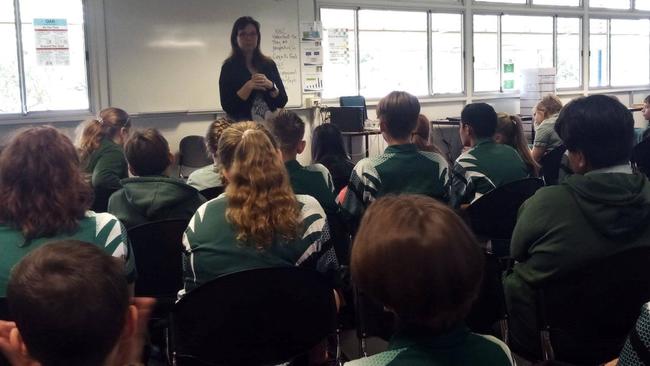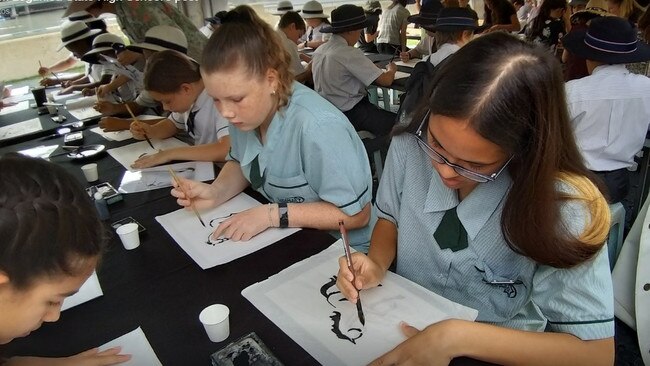Teacher v students: Best and worst resourced Logan schools
Schools in Logan are coping with the population boom and are sticking to the state-regulated class sizes of about 28 students in most classes. One high school added a new building this year to cater for the growth.
Schools Hub
Don't miss out on the headlines from Schools Hub. Followed categories will be added to My News.
The schools with Logan’s most crowded and best resourced classrooms have been revealed.
An analysis of national data from the Australian Curriculum, Assessment and Reporting Authority has revealed the schools where teachers have the most students to teach.
The figures showed in 2018, in the Logan region, there were more students per teacher at St Edward the Confessor School than any other school.
MOST IMPROVED NAPLAN SCHOOLS IN LOGAN
EDUCATION MINISTER ON NAPLAN AT BEENLEIGH — VIDEO
According to the most up-to-date data which includes all state and private schools nationally, St Edward the Confessor School at Daisy Hill, had 18.5 students for every teacher, the highest in the Logan area.
The second highest student-teacher ratios were at St Bernardine’s School, in Vergulde Rd, Regents Park, where there was an average of 18.2 students for every teacher at the school.
At YMCA Vocational School in Kingston, there were 17.7 students for every teacher, the Logan region’s third highest.
In contrast, there was one teacher for every 4.2 students at Beenleigh Special School, the region’s lowest ratio of students per teacher.
Other schools which scored well included Logan City Special School, on Wembley Rd, Logan Central, where there were 4.3 students per teacher.
The figures show at North Maclean’s Australian Technology and Agricultural College there were 5.3 students per teacher, the third lowest ratio in the Logan region.

Principal at Beenleigh State High School Matt O’Hanlon said most classes at his school had 28 students but many were smaller than that to cater for students with special needs.
“At Beenleigh High, we have 1250 students and about 100 teachers and we have grown by about 100 students a year for the past four years,” he said.
“Education Queensland has policies around class sizes which we adhere to but we also use our Investing for Schools funding to purchase other teachers and aides to support programs where students need additional support,” Mr O’Hanlon said.
“This frees up teachers to allows them to focus on literacy and numeracy or a child who needs intensive support.
“We believe that has helped us to get consistent relative gains on NAPLAN.
“Buying additional staff also allows us to have some smaller classes to target specific issues namely reading.”
Mr O’Hanlon said the school added a new building this year to cater for the growth in student numbers.
“That’s our school’s first new building since 1980
This year, the state government allocated $13.8 billion for education in its budget, an increase of 6.1 per cent on last year.
That will be spent on an extra 1000 teachers and an extra 3700 teachers over four years.
There was also money for 200 extra teacher aides.
Education Minister Grace Grace said that money assisted in meeting class-size targets.
She said last year, 93per cent of state primary school classes and 97per cent of state secondary classes met or were better than class size targets.
“And the majority of classes that were over target were only over by one or two students,” she said.
Mrs Grace also said eight new schools would open next year and a further five in 2021.
Schools are resourced each year on the basis of their Day 8 enrolments to achieve the established class size targets of 25 students per class in Prep to Year 3 and years 11 and 12, and 28 students per class in years 4 to 10.
She said schools also received funding under the $264 million Investing for Success program which provides schools with the flexibility to employ additional teachers and support staff.
“In the case of Loganlea State High School, as one example, the lower ratio includes extra teachers allocated to their large special education unit and additional teachers for students who have English as their second language,” Mrs Grace said.

Loganlea High had a ratio of 9.6 students per teacher.
Principal Farleigh said his school had was proud of its “small school” learning environment.
“It has allowed us to create a strong network between our students, their families, our staff and the wider community,” he said.
“We will still run elective classes even if a small number of students chose the subject, as we want to make sure our students have the same opportunities as students in larger schools.
“This includes opportunities such as our surf lifesaving program. Next week, we will have 12 students and two teachers attending Kirra Surf Life Saving club for the week as they gain qualifications necessary to become surf lifesavers.
“They will also receive points to go towards their Queensland Certificate of Education.
“You cannot run a program such as this with a large teacher-to-student ratio.
“We are also strategic and innovative in providing support to students. This includes our co-teaching model, where we have some classes with two teachers running the lesson to ensure students are getting the support they need.”

According to ACARA, the national student-teacher ratio was 13.5 students for every teacher.
Across the country, independent private schools had the lowest student-to-teacher ratios with 11.7 students to every teacher.
Government schools had an average of 13.8 students for every teacher, while Catholic schools had an average of 14 students for every teacher.
HOW OTHER REGIONS COMPARE
Student-teacher ratios do not take into account teacher aides or non-teaching staff at schools, only the full-time equivalent teachers.
The ACARA data related only to the total teachers and total students in each school.
The teacher to student ratio was determined by dividing total students by total teachers.
Student-teacher ratios do not take into account teacher aides or non-teaching staff at schools, only the full-time equivalent teachers.

The Queensland Department of Education has targets for class sizes and student/teacher ratios with 25 students per teacher for Prep-Year 3 and Years 11-12, and 28 students per teacher for Years 4 to 10.
A Department spokesman said, “Last year, 93 per cent of state primary school classes and 97 per cent of state secondary classes met or were better than class size targets, and the majority of classes that were over target were only over by one or two students.
“The proportion of classes that met or were better than class size targets has increased each year since 2015 when 88 per cent or primary school classes met or were better than the targets.
“The increase in the proportion of classes meeting or achieving targets has been made possible due to continuing Queensland Government investment in additional teachers.”
The spokeperson said while targets were an important consideration in the formation of classes, the actual make-up of classes was determined at the school level by principals in consultation with staff.
“For example, a principal may form a class with one or two students over the target to keep students of the same year level together, rather than forming other class combinations that might split the age cohort,” the spokesman said.
The ACARA data related only to the total teachers and total students in each school.
The teacher to student ratio was determined by dividing total students by total teachers.
Student-teacher ratios do not take into account teacher aides or non-teaching staff at schools, only the full-time equivalent teachers.

Logan’s most crowded classrooms
St Edward the Confessor School: 18.5 students per teacher
St Bernardine’s School: 18.2 students per teacher
YMCA Vocational School: 17.7 students per teacher
Woongoolba State School: 17.1 students per teacher
Emmaus College: 16.7 students per teacher
Loganholme State School: 16.6 students per teacher
Groves Christian College: 16.4 students per teacher
St Matthew’s School: 16.3 students per teacher
Flagstone State School: 16.1 students per teacher
Shailer Park State School: 16.0 students per teacher
Logan’s least crowded classrooms
Beenleigh Special School: 4.2 students per teacher
Logan City Special School: 4.3 students per teacher
Australian Technology and Agricultural College: 5.3 students per teacher
Loganlea State High School: 9.6 students per teacher
St Clare’s Primary School: 10.1 students per teacher
Woodridge State High School: 10.5 students per teacher
Springwood State High School: 10.5 students per teacher
Woodridge State School: 10.8 students per teacher
Kingston State College: 10.8 students per teacher
The Centre Education Programme: 10.9 students per teacher


